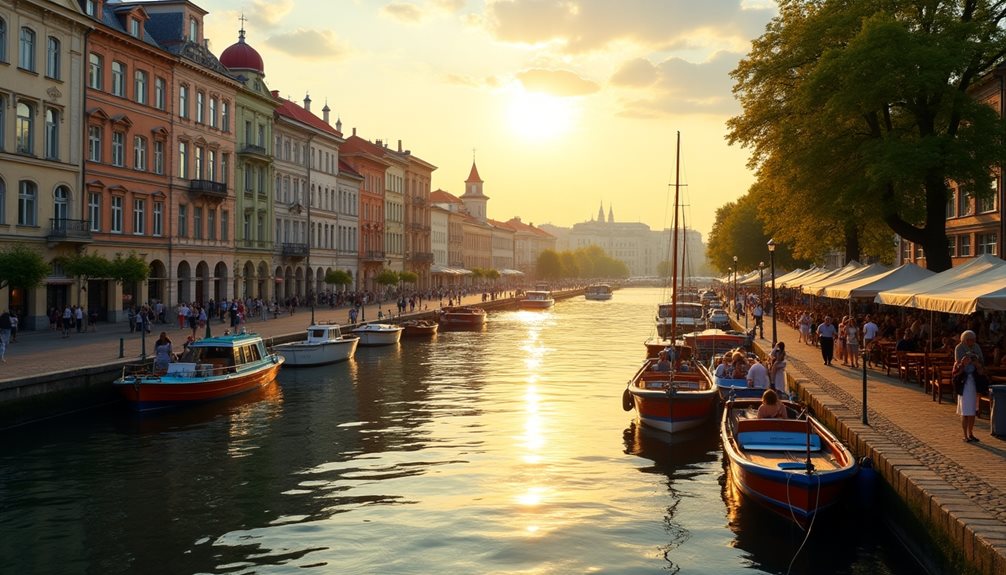Just outside Moscow lies a village that may not impress by size or population but captivates with something far more intriguing—its name. Holding the record for the longest official geographical name in Russia, this settlement’s title stretches to an extraordinary 63 letters: Посёлок опытного хозяйства центральной торфо-болотной опытной станции (Poselok opytnogo khozyaystva tsentralnoy torfo-bolotnoy opytnoy stantsii).
The Longest Official Geographical Name in Russia

Among Russia’s vast and diverse geographical landscape, one name stands out for its remarkable length and specificity: Poselok opytnogo khozyaystva tsentralnoy torfo-bolotnoy opytnoy stantsii.
Far from a random string of words, this extensive name offers a window into Russian cultural and historical traditions of place naming, where clarity and detailed description are valued over simplicity. The name itself reveals the village’s origins and purpose—as the central experimental station dedicated to peat-bog research and agriculture innovation.
This unique naming practice reflects a broader pattern in Russian geography, where place names often serve as mini-histories, encapsulating the function, location, or heritage of a place. Beyond its linguistic curiosity, the village plays an important role in scientific exploration and environmental management, highlighting Russia’s rich tradition of blending nature, science, and culture.
During the Soviet era, naming conventions often reflected the state’s focus on scientific progress and industrialization. These lengthy names were not just functional but also ideological, emphasizing the importance of collective efforts in agriculture, science, and production. This tradition has left a unique linguistic footprint that continues to intrigue linguists and historians alike.
Exploring this village and its extraordinary name invites us to appreciate how language can preserve history and identity, making even the smallest places fascinating chapters in a country’s story.
Historical Origins of the Settlement
In the early 20th century, the area around what would become the settlement of Poselok opytnogo khozyaystva tsentralnoy torfo-bolotnoy opytnoy stantsii was largely untouched wilderness. Situated in the floodplain of the Yakhroma River, this region was characterized by extensive marshlands with rich but challenging peat and bog soils. These soils, while initially seen as an obstacle to traditional farming, soon attracted the attention of scientists and agronomists interested in exploring their potential.
The unique hydrological and soil conditions presented an ideal natural laboratory for experimental agriculture. Researchers aimed to understand how to effectively manage and convert the marshy terrain into productive land through drainage, soil reclamation, and specialized cultivation techniques. This work was part of a broader effort in the Soviet Union during the mid-20th century to increase agricultural output by developing previously unusable lands.
By the 1950s, these scientific endeavors culminated in the formal establishment of a peat-marsh experimental station. This facility became a center for innovation in land use, focusing on sustainable agricultural practices adapted specifically for peat bogs and marsh soils. The station’s work included testing different crops, improving drainage systems, and studying the ecological impact of land reclamation.
The founding of this experimental station directly led to the formation of the surrounding settlement, as workers, scientists, and their families moved to the area to support ongoing research and development efforts. Over time, Poselok opytnogo khozyaystva grew into a community deeply connected to its roots in agricultural science and rural advancement.
Today, the settlement stands as a testament to mid-century efforts to transform challenging natural environments into productive landscapes while balancing ecological concerns—a legacy of innovation in experimental agriculture that shaped the region’s development.
Life and Research at the Experimental Station
Since its founding, the experimental station has served as a vital center for agricultural research and innovation, with a specialized focus on peatlands and peat bog ecosystems. These unique environments, rich in organic matter accumulated over thousands of years, present both challenges and opportunities for sustainable land use and crop production.
The researchers at this remote facility conduct extensive studies on the properties and management of peat soils. Their work includes investigating soil reclamation techniques to convert waterlogged and acidic peatlands into productive agricultural areas without causing ecological degradation. This involves developing methods to improve soil aeration, nutrient availability, and water management—key factors that influence crop growth on peat substrates.
A major area of innovation at the station is the optimization of vegetable cultivation on reclaimed peat soils. By tailoring planting schedules, crop varieties, and fertilization regimes to the unique characteristics of peatlands, scientists have significantly increased yields of vegetables such as carrots, onions, and leafy greens. These advancements have helped transform previously marginal marshy terrains into fertile farmland, contributing to regional food security.
Daily life at the station is characterized by rigorous scientific experimentation combined with close observation of environmental conditions. Researchers use a variety of tools, including soil sensors, hydrological monitoring systems, and laboratory analyses, to track changes in soil chemistry, moisture levels, and microbial activity. This detailed monitoring supports adaptive management strategies that balance agricultural productivity with ecosystem conservation.
Beyond agriculture, the station also studies the ecological functions of peat bogs, such as their role in carbon storage and water regulation. Understanding these processes is critical in the context of climate change, as peatlands are significant carbon sinks that help mitigate greenhouse gas emissions.
The commitment of the experimental station to advancing knowledge about peat ecosystems has made it a cornerstone institution in regional agricultural development. Its research outcomes not only enhance sustainable farming practices but also guide policies aimed at preserving fragile wetland environments while supporting economic growth.
![]()
Peat Bogs in Russian Ecology and Economy
Peat bogs are widespread across Russia, covering an estimated 20% of its land area, making them one of the country’s most extensive wetland ecosystems. These bogs have formed over thousands of years through the accumulation and partial decay of plant material in waterlogged conditions. They play a crucial role in Russia’s ecology by acting as significant carbon sinks, regulating water cycles, and providing unique habitats for diverse plant and animal species, some of which are rare or endangered.
From an economic perspective, peat bogs have been a valuable natural resource for centuries. Peat, the partially decomposed organic material found in these bogs, has been traditionally used as a source of fuel, especially in remote rural areas where other energy sources were scarce. In modern times, peat continues to be harvested for horticulture, where it is prized as a soil conditioner and growing medium due to its ability to retain moisture and nutrients. Additionally, peat has applications in medicine and spa treatments owing to its antiseptic and anti-inflammatory properties.
The sustainable management of peat bogs is critical, given their ecological sensitivity and slow regeneration rate. Research stations dedicated to studying Russian peatlands focus on developing methods to balance economic use with conservation efforts. This includes investigating techniques to minimize environmental damage during peat extraction, restoring degraded bogs, and promoting alternative uses that do not compromise the ecosystem’s health. Moreover, protecting peatlands is essential in mitigating climate change, as disturbing these carbon-rich soils can release large amounts of greenhouse gases into the atmosphere.
In summary, peat bogs in Russia are indispensable both ecologically and economically. Continued scientific research and responsible management practices are vital to preserving these fragile landscapes while supporting the communities that depend on them.
A Cultural Look at Russia’s Lengthy Place Names
Russia is known for having some of the longest official geographical names in the world. These names are not only interesting because of their length but also because they reveal a lot about the country’s history, culture, and language structure. For English speakers learning Russian, understanding these place names offers a fascinating window into how Russian communicates complex ideas and traditions in a single name.
Why Are Russian Place Names So Long?
Russian place names often function like short descriptions, combining several words that explain the location’s purpose, origin, or historical background. Unlike English, which tends to use shorter names or separate descriptive phrases, Russian can form long compound names that serve almost like sentences. This is partly due to the use of:
- Compound nouns (сложные существительные)
- Adjective chains (цепочки прилагательных)
- Genitive constructions (родительный падеж) for possession or description
For example, the name:
Poselok opytnogo khozyaystva tsentralnoy torfo-bolotnoy opytnoy stantsii (Посёлок опытного хозяйства центральной торфо-болотной опытной станции)
means Settlement of the experimental farm of the central peat-bog experimental station. Each word adds a layer of meaning, and together they describe the settlement’s function precisely.
Cultural Significance Behind the Names
These long names are not random. They usually commemorate:
- Agricultural or industrial innovation: Many names include terms like “opytnogo khozyaystva” (experimental farm) reflecting Soviet-era scientific advances.
- Historical periods or events: Names like Poselok tsentralnoy usadby sovkhoza 40 let Oktyabrya (Settlement of the central estate of the state farm “40 years of October”) commemorate historical milestones, here referring to the October Revolution.
- Geographical features: Words such as “torfo-bolotnoy” (peat-bog) describe the natural environment.
This naming tradition embeds history, geography, and culture directly into place names, making them living records.
Linguistic Features That Shape These Names
- Use of Adjectives in Series: Russian allows multiple adjectives to modify a noun consecutively without conjunctions.
Example:- tsentralnoy (central)
- torfo-bolotnoy (peat-bog)
- opytnoy (experimental)
- Genitive Case Chains: This case is heavily used to show relationships between words, especially possession or origin.
Example:- khozyaystva (of the farm)
- stantsii (of the station)
- Nominalization and Compounding: Combining nouns and adjectives into one phrase to build detailed meanings.
Related Russian Terms
- Посёлок (posyolok) – Settlement or village
- Опытное хозяйство (opытnoe khozyaystvo) – Experimental farm
- Центральный (tsentralnyy) – Central
- Торфо-болотной (torfo-bolotnoy) – Peat-bog (adjective form)
- Опытная станция (opытnaya stantsiya) – Experimental station
- Совхоз (sovkhoz) – State farm (a Soviet-era agricultural enterprise)
- Усадьба (usadba) – Estate or homestead
- Географическое название (geograficheskoe nazvanie) – Geographical name
Insightful Observations
- In English, long place names are usually shortened or abbreviated for convenience. In Russian rural or administrative contexts, the full name is often used formally, underlining precision and respect for tradition.
- The length and complexity reflect a historical tendency toward detailed descriptions over catchy or simple names.
- Learning how to break down these long names into smaller parts improves understanding of Russian grammar and vocabulary, especially cases and adjective-noun agreement.
- These place names highlight how language and culture intertwine; understanding them enriches knowledge beyond grammar—into history, geography, and societal values.
Exploring Russia’s lengthy place names offers an excellent way to deepen your grasp of Russian language structure and cultural context simultaneously. It shows how a language can carry layers of meaning in a single phrase and reflects a unique approach to naming places that English speakers might find both challenging and fascinating.
Connection to Russian Folklore and Landscape
Peatlands and marshes hold a significant place in Russian folklore and traditional stories, often portrayed as mysterious, sacred, and even otherworldly landscapes. These wetlands are frequently depicted as places where the boundary between the natural and supernatural worlds blurs, reflecting the deep respect and awe that rural communities historically held for these environments.
In Russian folk tales, peat bogs and marshes are commonly associated with spirits and mythical creatures such as the Rusalka—water nymphs believed to inhabit lakes, rivers, and swamps. These beings could be both benevolent and dangerous, embodying the unpredictable power of nature. The marshes are also sometimes described as haunted or enchanted, places where travelers might lose their way or encounter supernatural forces, reinforcing a sense of caution and reverence toward these landscapes.
Beyond mythology, peatlands have practical importance in Russian history and culture. They were sources of peat, a natural fuel used extensively for heating and cooking in rural areas, especially in northern regions with limited access to wood or coal. This practical use further entwined people’s lives with these ecosystems.
The cultural reverence for peatlands and marshes contributes to a broader understanding of their value beyond ecology. These landscapes are not only biodiversity hotspots and carbon sinks but also carriers of cultural memory and identity. Protecting peatlands means preserving a living connection to Russia’s past, its folklore, and the profound relationship between humans and the natural world embedded in traditional stories.
This cultural dimension highlights why conservation efforts must consider both ecological and cultural factors, ensuring these unique landscapes remain intact for future generations to appreciate scientifically and culturally.
Exploring Unique Rural Destinations in the Moscow Region
Exploring Unique Rural Destinations in the Moscow Region
Many travelers searching for authentic and meaningful experiences often overlook the quiet charm of rural settlements within the Moscow Region. These villages and small towns offer a rich tapestry of cultural, historical, and natural significance that is distinct from the busy urban centers.
One notable example is the peat-marsh experimental station village. This settlement is not just a quaint rural community but also an important site for agricultural and ecological research. Established in the Soviet era, peat-marsh stations were designed to study and develop methods for reclaiming and managing peatlands, which are vital for both agriculture and environmental conservation. Visitors to such villages can witness ongoing scientific work aimed at improving soil fertility, controlling water levels, and preserving biodiversity in marshy landscapes.
Rural tourism in these areas provides an opportunity to engage directly with communities that maintain traditional Russian lifestyles. Many residents still practice age-old crafts, farming techniques, and folk customs that have been passed down through generations. By visiting local markets, farms, or craft workshops, travelers can experience the everyday life of rural Russia, including seasonal festivals and culinary specialties unique to each locality.
In addition to cultural heritage, the natural environment surrounding these villages is often breathtaking. The Moscow Region’s countryside features diverse landscapes—rivers, forests, wetlands, and meadows—that support a wide range of wildlife. Hiking trails and eco-tourism activities allow visitors to explore these habitats while learning about conservation efforts.
For foreign travelers planning a visit to Russia, here are a few suggestions to enhance their rural experience:
- Visit the village of Abramtsevo: Known for its historic artists’ colony and beautiful manor, Abramtsevo offers insight into 19th-century Russian art and culture. Travelers can tour museums, galleries, and enjoy nature walks in the surrounding forest.
- Explore the ancient village of Zvenigorod: Just outside Moscow, Zvenigorod combines medieval architecture with traditional rural life. Visitors can explore its stunning 12th-century cathedral and then enjoy local crafts and cuisine in village markets.
- Participate in a traditional Russian cooking workshop: Many rural settlements offer workshops where visitors can learn to prepare dishes like borscht, pelmeni, or blini using fresh local ingredients, providing a delicious way to connect with Russian culture.
Choosing to explore these lesser-known rural destinations offers a break from conventional tourist routes. It invites visitors to discover a different side of Russia—one where nature and tradition coexist with scientific progress. Such experiences deepen understanding of the country’s diverse heritage, showing how local communities adapt and thrive while preserving their connection to the land.
In sum, rural tourism in the Moscow Region enriches travel with meaningful encounters that highlight natural beauty, cultural depth, and the enduring spirit of rural Russian life. It’s a chance to step off the beaten path and connect with places where history, environment, and community converge in unique ways.
![]()
A Name That Opens a Window to Russia’s Past and Present
The village with Russia’s longest official name is much more than a linguistic curiosity—it is a living story of scientific innovation, environmental stewardship, and cultural tradition. Through its descriptive title, it preserves the legacy of Soviet agricultural experimentation while highlighting ongoing efforts to balance progress with nature.
Exploring this village—and others like it—invites us to appreciate how language can serve as a gateway to history and identity. It reminds us that even the smallest places hold rich narratives waiting to be uncovered. For travelers and language enthusiasts alike, these lengthy names offer a fascinating challenge and a deeper connection to Russia’s vast cultural landscape.
In a world that often favors simplicity, Russia’s longest village name stands proudly as a testament to complexity, precision, and enduring pride in place—an extraordinary story told in 63 letters.




